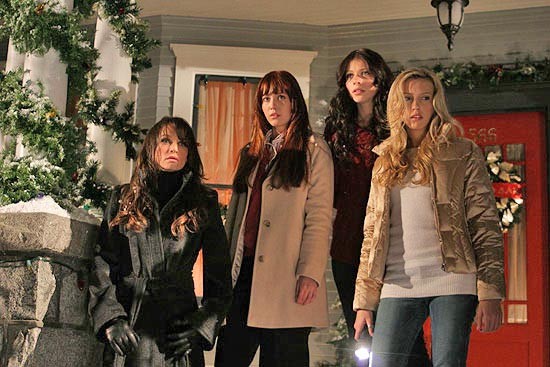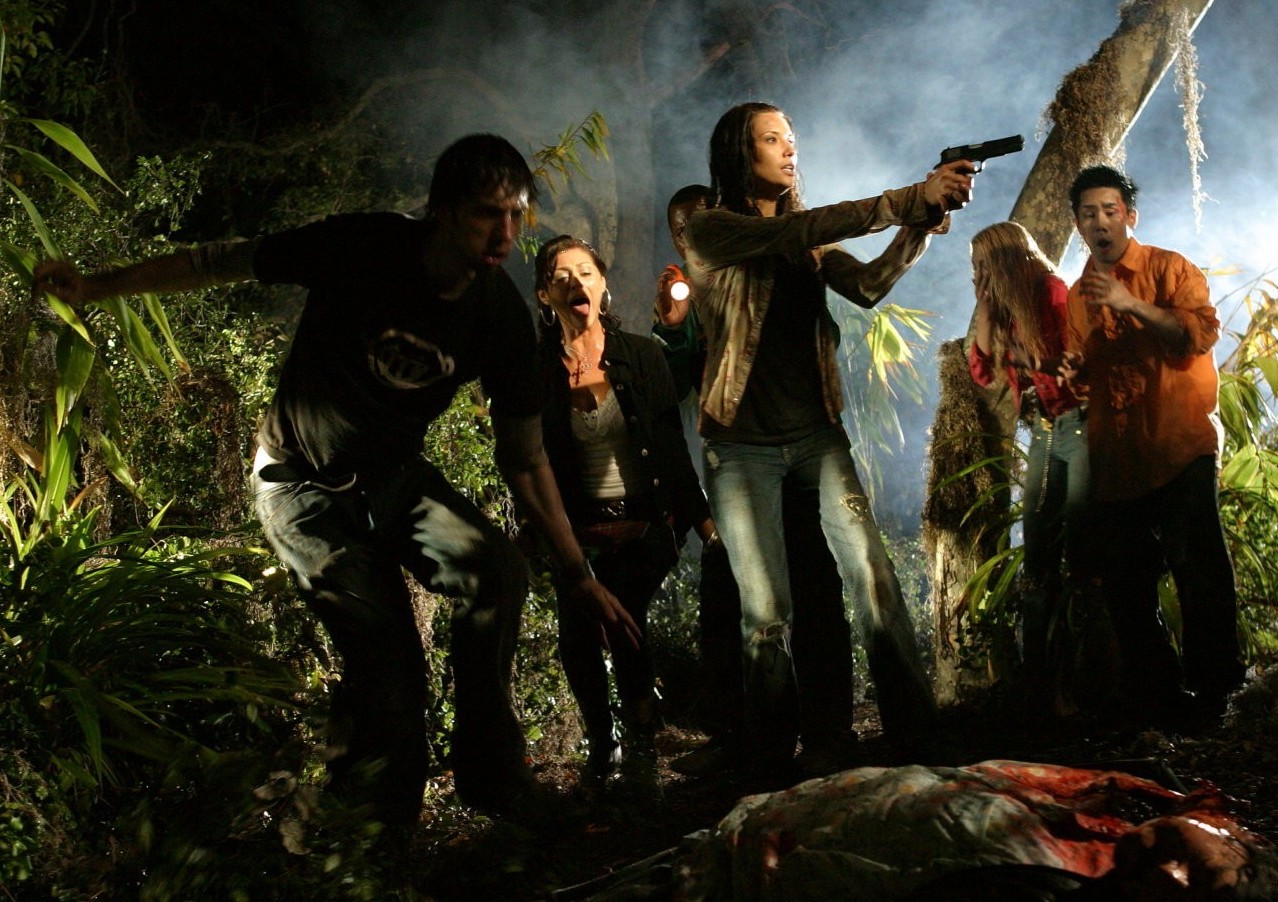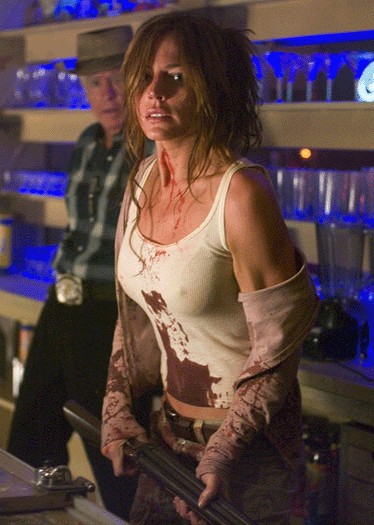 [EDITOR’S NOTE: EVIL DEAD 2 makes another appearance on home video today, this time in the Blu-ray format, so we took this opportunity to post a retrospective-review of the film, including an interview with director Sam Raimi.
[EDITOR’S NOTE: EVIL DEAD 2 makes another appearance on home video today, this time in the Blu-ray format, so we took this opportunity to post a retrospective-review of the film, including an interview with director Sam Raimi.
Hands down absolutely one of the greatest achievements in the horror genre—ever. This is literally one of those films that have to be seen to be believed—it’s outrageous, over-the-top, and beyond what you could possibly imagine, if you haven’t already seen it. It’s a high-octane visual assault on the senses that starts fast and keeps accelerating, slowing down only enough to change gears from scene to scene. If you’re one of those people hung up on literary values like characterization and narrative coherence (and by the way, why are you even reading this?), then this film is not for you; if, however, you really appreciate good cinema—filmmaking pushed to the limits of what can be achieved with camera techniques and editing—then you’re guaranteed to enjoy this mind-blowing roller-coaster ride. Continue reading “Evil Dead 2 (1987) – Film & DVD Review”
Tag: gore movies
Black Christmas (2006) – Film & DVD Review
 [NOTE: Today, the Weinstein Company is releasing a DVD double bill that includes two disappointing remakes: BLACK CHRISTMAS and PULSE. With that in mind, we offer this review of the unrated BLACK CHRISTAMS DVD.] This ill-conceived remake takes the premise of the effective original and turns it into a routine gorefest. The 1974 version of BLACK CHRISTMAS, which predates HALLOWEEN by four years, is the true grandfather of the ’70s slasher craze, with the presence of its unseen serial killer suggested through the use of a subjective camera stalking a group of sorority sisters during the holiday season. Not content simply to redo what worked before, writer-director Glen Morgan throws in bits and pieces of other films, creating a mismatched quilt that ultimately falls to pieces; then he tries to hide the ripped seams beneath a bucket-full of blood. The result is a tedious film that seldom scares, the eruptions of grue serving simply to remind you of how desperate the film is to achieve its horror.
[NOTE: Today, the Weinstein Company is releasing a DVD double bill that includes two disappointing remakes: BLACK CHRISTMAS and PULSE. With that in mind, we offer this review of the unrated BLACK CHRISTAMS DVD.] This ill-conceived remake takes the premise of the effective original and turns it into a routine gorefest. The 1974 version of BLACK CHRISTMAS, which predates HALLOWEEN by four years, is the true grandfather of the ’70s slasher craze, with the presence of its unseen serial killer suggested through the use of a subjective camera stalking a group of sorority sisters during the holiday season. Not content simply to redo what worked before, writer-director Glen Morgan throws in bits and pieces of other films, creating a mismatched quilt that ultimately falls to pieces; then he tries to hide the ripped seams beneath a bucket-full of blood. The result is a tedious film that seldom scares, the eruptions of grue serving simply to remind you of how desperate the film is to achieve its horror.
Perhaps the biggest strength of the first BLACK CHRISTMAS was the mystery surrounding its killer, whose identity is never revealed (although his name seems to be Billy, based on the disturbing obscene phone calls he makes throughout the movie). The remake commits the catastrophic mistake of showcasing a back-story for Billy, through an interminable series of flashbacks that bog down the first half of the film without telling us anything we really need to know.
By setting up a story in which Billy was institutionalized for killing family members years ago, then escapes on the anniversary of his crimes to return home, Morgan turns BLACK CHRISTMAS into an inadvertent remake of HALLOWEEN. In effect, what was once original becomes a rehash of its own imitators. Morgan then compounds the problem by adding in bits of PSYCHO IV (the awful relationship between a boy and his mom that turns him into a killer) and even Dario Argento’s DEEP RED (Mom kills Dad at Christmas, which really freaks junior out).
But what really sinks the film is that it recycles the tired clichés of 1930s mystery movies. The new BLACK CHRISTMAS is a manipulative who-done-it wherein clues are kept deliberately vague and characters wear dark and sinister expressions like signs that read “SUSPECT ME!” Proving that no writer’s device is too old to be hauled out of the mothballs, the roads are closed by snow (of course), which prevents the police from arriving, but a new character unexpectedly pops up at a key moment, so that we will think she might be the killer. And just to keep the audience guessing (is she who she claims?), the last name on her driver’s license does not match her sister at the sorority house.
Of course, the sum total effect of this is almost zero, because we know the story is about a killer who recently escaped from his cell, which pretty much eliminates all the characters as suspects. The only question mark arises from the fact that the first murders occur before Billy’s escape, so we know there must be a second murderer. Since all those flashbacks tell us Billy had a sister, you don’t have to be Sherlock Holmes to figure out who the accomplice might be.
With its uninvolving mystery, BLACK CHRISTMAS relies on a series of gruesome deaths to generate whatever feeble horror it can manage. The gore is overdone and quite gratuitous (the killer for some reason enjoys raw eyeballs, though how that figures into the homicidal psychopathology is not clear). With little suspense, a cast of unlikable and mostly interchangeable characters, and a silly storyline (which illogically brings the killers back to life for a few more shocks in the final reel), the new BLACK CHRISTMAS ranks as one of the worst examples of a debased form. Viewers would be well advised to leave this Christmas present unwrapped.
TRIVIA
Actress Andrea Martin, who appeared as one of the sorority sisters in the first BLACK CHRISTMAS, shows up in the remake as the house den mother.
 BLACK CHRISTMAS perpetuates the New Age myth that the Christian holiday of Christmas is simply a Roman holiday in disguise, citing mistletoe and Christmas trees as pagan symbols of seasonal rebirth. Even though one of the film’s characters is supposed to be a Christian believer, she does not bother to point out that the Romans were not celebrating the birth of the Messiah, nor that most of the traditional accoutrement’s of Christmas date more from the Victorian era, not from ancient Rome.
BLACK CHRISTMAS perpetuates the New Age myth that the Christian holiday of Christmas is simply a Roman holiday in disguise, citing mistletoe and Christmas trees as pagan symbols of seasonal rebirth. Even though one of the film’s characters is supposed to be a Christian believer, she does not bother to point out that the Romans were not celebrating the birth of the Messiah, nor that most of the traditional accoutrement’s of Christmas date more from the Victorian era, not from ancient Rome.
In one of the film’s more bizarre stretches of incredible illogic, one character insists that what Santa Claus does (sneaking into your house) is this is no different from what Billy has done. In a roomful of college students, no one is smart enough to point out that there is a considerable difference between leaving a lump of coal in a stocking, on the one hand, and, on the other hand, strangling someone to death and eating her eyeball.
DVD DETAILS
Dimension Films released BLACK CHRISTMAS on DVD in an Unrated Widescreen Edition (ASIN: B000MM0LIM) and an Unrated Full Screen Edition (ASIN: B000MM0LIW). The DVDs divide the film in twelve chapter stops, with English-language Dolby 5.1 surround sound and optional subtitles in English (for the Hearing Impaired) and Spanish. Bonus features include seven deleted, extended, or alternate scenes; three alternate endings; and two featurettes.
The Deleted/Alternate/Extended Scenes:
- “Someone in the Attic” is am overlong montage that introduces the sorority house and establishes the presence of the killer.
- “Christmas Ringtones” is a minor dialogue exchange.
- “Gift Exchange” features Lacy Chabert’s character unwrapping a giant dildo, which flops around to (allegedly) hilarious effect.
- “The Girls Discuss Kyle and Eve” is a bit of dialogue that points a finger at two suspects.
- “Extended Version – Phone Call From Dana” offers more suspicious finger-pointing at Eve.
- “International Version – Melissa Killed in the Hallways” is a longer version of Melissa’s death, featuring the killer chomping down on an eyeball that goes “smoosh!”
- “Alternate Version – Lauren’s Death” more closely mimics the murder of Margot Kidder’s character in the original BLACK CHRISTMAS.
The Alternate Endings suggest that a more low-key approach was originally intended; the successive version amp up the final reel violence, trying to end with a bigger bang:
- Leigh (Kristen Cloke) delivers a speech about family to Kelli (Katie Cassidy) in the hospital. The inspiration message is undercut by a call from the cell phone of Cassidy’s dead boyfriend, implying that the killer is still active.
- As it is in the final film, Leigh’s inspirational speech is cut out. Leigh is called down to identify the body of Agnes, who turns out not to be in the body bag. Meanwhile, Billy dies in the E.R. from burns. Agnes invades Kelli’s hospital room, where Kelli electrocutes her (as in the finished film), before Kelli’s parents arrive to take her home.
- A nurse wheels Kelli into the E.R. room to see that Billy is really dead (a plot point weakened by the fact that he seems to be breathing). After Kelli’s parents arrive and take her home (as in Ending #2), Billy’s body goes missing. Ridiculously, the camera pans up to reveal his eye peering out from behind a smoke detector.
“What Have You Done – The Remaking of BLACK CHRISTMAS” is a standard puff piece crafted to promote the 2006 theatrical release. The back-patting and self-congratulatory tone is a bit off-putting (taking the film to a “different level” or “another level” is a repeated talking point). There are interviews with writer-director Glen Morgan, his producer-partner James Wong, the cast, and Bob Clark, who produced and directed the original film. The featurette suffers from an absence of footage from the original, despite much discussion about its similarities to and differences from the remake. This featurette’s highlight has to be Andrea Martin’s brief but hilarious EXORCIST impersonation – an apparent spoof of the raspy voice heard in BLACK CHRISTMAS’s obscene phone calls.
“May All Your Christmases Be Black – A Filmmaker’s Journey” is the more interesting of the two featurettes: it gives some insight into why the film turned out so badly. Glen Morgan laments the box office failure of his first directorial effort, a remake of WILLARD starring Crispen Glover, and offers this as a justification for pandering to the gore crowd (“giving the people what they want”) in the hope of turning BLACK CHRISTMAS a box office hit. Even though he insists that BLACK CHRISTMAS is not a slasher film, he admits to including shock scenes that he himself would prefer not to use. The featurette then takes an unnecessarily extended detour to examine Dean Friss, the film’s male focus-puller who ended up cast as the female serial killer Agnes. The piece wraps up with Morgan informing us that he will be on “Filmmakers Death Row” if BLACK CHRISTMAS flops. The unpleasant implication is that we should buy tickets and/or DVDs to enable Morgan to go on making films, even though he admits that commercial considerations are forcing him to make movies in a way that he himself does not like.
BLACK CHRISTMAS (2006). Directed by Glen Morgan. Screenlay by Morgan, based on the screenlay for “Black Christmas” (2974) by Roy Moore. Cast: Katie Cassidy, Michelle Trachtenberg, Kristen Cloke, Crystal Lowe, Lacey Chabert, mary Elizabeth Winstead, Oliver Hudson, Andrea, Martin, Jessica Harmon, Leela Savasta
Theatre of Blood (1973) – A Retrospective
 This is generally regarded as one of the highlight’s of Vincent Price’s later career, a film that fused his reputation as a horror star with his penchant for self-parody, casting him as Edward Lionheart, a hammy Shakespearean actor killing off the critics who denied him a prestigious award. Besides being wickedly inventive in terms of concocting a series of imaginative demises, the screenplay is unorthodox in structure. The victims walk on like a series of targets in a shooting gallery, doing little to elicit sympathy. The police are on hand to investigate, but they achieve little (except for interrogating an alcoholic who finally breaks under pressure and spills the beans just in time for a climactic race to save the final victim). The nominal protagonist, Peregrine Devlin (played by Ian Hendry), has little to recommend him; motivated mostly by self-interest (in his own survival), he engenders audience identification mostly by virtue of being onscreen long enough to become a familiar presence. The leading lady, instead of a love interest, turns out to be complicit in the crimes. And the villain of the piece, who is the real focus of the story’s attention, remains mostly an enigma. Continue reading “Theatre of Blood (1973) – A Retrospective”
This is generally regarded as one of the highlight’s of Vincent Price’s later career, a film that fused his reputation as a horror star with his penchant for self-parody, casting him as Edward Lionheart, a hammy Shakespearean actor killing off the critics who denied him a prestigious award. Besides being wickedly inventive in terms of concocting a series of imaginative demises, the screenplay is unorthodox in structure. The victims walk on like a series of targets in a shooting gallery, doing little to elicit sympathy. The police are on hand to investigate, but they achieve little (except for interrogating an alcoholic who finally breaks under pressure and spills the beans just in time for a climactic race to save the final victim). The nominal protagonist, Peregrine Devlin (played by Ian Hendry), has little to recommend him; motivated mostly by self-interest (in his own survival), he engenders audience identification mostly by virtue of being onscreen long enough to become a familiar presence. The leading lady, instead of a love interest, turns out to be complicit in the crimes. And the villain of the piece, who is the real focus of the story’s attention, remains mostly an enigma. Continue reading “Theatre of Blood (1973) – A Retrospective”
Snoop Dogg's Hood of Horror (2006) – Film Review
 This is a fairly feeble attempt to create an old-fashioned horror anthology, in the manner of TALES FROM THE HOOD, featuring three short stories – set in the hood, naturally – linked together by rapper Snoop Dogg. Unfortunately, the film gets off to an extremely slow start with an animated sequence that sets up the mythology: a gang-banger is turned into an angel-or-demon, one among many who keep an eye out on those who take the wrong path in life. The animation consists mostly of static figures sitting in cars, with blurry backgrounds moving behind them to suggest speed, and the character design bears little if any resemblance to Snoop Dogg. Continue reading “Snoop Dogg's Hood of Horror (2006) – Film Review”
This is a fairly feeble attempt to create an old-fashioned horror anthology, in the manner of TALES FROM THE HOOD, featuring three short stories – set in the hood, naturally – linked together by rapper Snoop Dogg. Unfortunately, the film gets off to an extremely slow start with an animated sequence that sets up the mythology: a gang-banger is turned into an angel-or-demon, one among many who keep an eye out on those who take the wrong path in life. The animation consists mostly of static figures sitting in cars, with blurry backgrounds moving behind them to suggest speed, and the character design bears little if any resemblance to Snoop Dogg. Continue reading “Snoop Dogg's Hood of Horror (2006) – Film Review”
HATCHET: Interview with writer-director Adam Green
HATCHET is a rare achievement: an homage that exceeds the originals. Inspired by ’80s slasher icons like Michael Myers and Jason Voorhees., writer-director Adam Green has fashioned an atmospheric, fun-filled horror thrill-ride that delivers the gore, along with clever characterization and doses of humor that make the film funny and scary, not just an exercise in spilling entrails.

Anchor Bay Entertainment releases the film in limited engagements nationwide on Friday, September 7; unfortunately, unlike the HALLOWEEN remake (which is in over 3,000 theatres), HATCHET will screen in only a couple dozen cities around the country. (You can find a partial list here, but check your local listings to be sure.) Even this small exposure is quite an achievement when you consider that the film was a labor of love, produced independently because it did not fit the current Hollywood formula. Below the fold, you will find our interview with Green, who describes the long and winding road he took to get his “old school horror” film onto the big screen
Continue reading “HATCHET: Interview with writer-director Adam Green”
Slicing up Sweeney
 Where would we be without all the gore-hound websites shrieking louder than Marion Crane taking a shower at the Bates Motel every time they think a few less drops of precious blood may be shed in order to secure a PG-13 rating? Well, we would be without confused editorializing like this:
Where would we be without all the gore-hound websites shrieking louder than Marion Crane taking a shower at the Bates Motel every time they think a few less drops of precious blood may be shed in order to secure a PG-13 rating? Well, we would be without confused editorializing like this:
Apparently, Tim Burton went blood-simple on the set of SWEENEY TODD, because Warner Bros. is now telling him his gory musical is way too harsh – and must be cut down for a PG-13.
[…]
What did Warner Bros. expect they were getting into with this very un-PG-13 material with Tim Burton at the helm? HAIRSPRAY? When allowed to, Burton loves chopping people up. (see SLEEPY HOLLOW– which was rated R and seems like SWEENEY TODD’s closest relative.) They may be thinking that this film is a hard enough sell without an R rating to exascerbate things – but I have a feeling they’re going to have a hit on their hands here – so release the thing in all its gooey glory!
You gotta love anybody who stands up against censorship – well, actually, no you don’t, at least not when they don’t know what they’re talking about.
First thing’s first: SWEENEY TODD is a very old story that has been told many times – in books, on stage, and on the screen – without R-rated violence, so it’s not as if the integrity of the story would be breached by avoiding graphic bloodshed.
Second thing: This particularly version of SWEENEY TODD is based on a well-loved popular musical; the film version is clearly intended to appeal to a wide audience, not to gore hounds pissed off that their favorite torture porn movies aren’t making money anymore.
Third – and absolutely most important – what prompted the above-quoted tirade was this article in the Daily Mail – which is an English news publication, writing from an English perspective about what might – or might not – happen to the film when it is released in England. In other words, the thinly sourced, highly speculative article has nothing to say about whether the film will be trimmed to get a PG-13 rating from the Motion Picture Academy of America because the MPAA does not rate movies for British release.
Here is the relevant passage:
In its present form the film would merit an 18 rating, but Warner Brothers would prefer it to have a 15.
Now pay close attention: these are British classifications, and the Brits have radically different standards from ours regarding what is and is not objectionable on screen?
So to summarize:
- SWEENEY TODD has not been submitted to the MPAA
- SWEENEY TODD has not received an R-rating from the MPAA
- Ergo, SWEENEY TODD has not been cut in order to change the rating from R to PG-13.
Yes, the Brits may be quaking in their boots over how much blood can fly before a black comedy turns into a deep red massacre, but that’s no reason for us to get a case of the vapors on this side of the Atlantic. Before we launch an anti-editing protest, let’s at least wait until there’s something to protest.
UPDATE: One day later, Christopher Campbell recycles most of my points in this post at Cinematical.
Hatchet (2006)
Slasher homage exceeds originals
This may be the bucket of blood that splatter fans were eagerly anticipating (those for whom FRIDAY THE 13TH is a fond memory), but it is also an excellent horror film with solid scripting and strong performances that make it appealing to a wider audience.
The movie is an unapologetic throwback to 1980s slasher films, with numerous tips of the hats to its progenitors. Robert Englund (best known as dream demon Freddy Kruger) has a cameo as an early victim; Tony Todd (best known as Candyman) puts in a brief, comical appearance; makeup man John Carl Buechler (FROM BEYOND) provides the carnage and appears on-screen as the obligatory prophet of doom, a drunken old loon warning the tourists that death awaits them in the swamp. Finally, Kane Hodder (best known as masked killer Jason Voorhees) plays the mad, mutant, and possibly supernatural psycho-killer.
Which is completely appropriate because HATCHET, like FRIDAY THE 13TH, is about some teen-agers stalked by a mad killer in the woods. The story follows a group of friends on vacation who decided to take a night-time boat tour; unfortunately, the boat runs aground, stranding them in the middle of territory presided over – or so legend has it – by the deformed off-spring of a lonely cabin-dweller who was killed by a Halloween prank gone wrong.
Set in the Louisiana bayou, the film has atmosphere to spare, and even the obligatory legend explaining the killer’s existence is presented with panache. The suggestion of supernatural overtones (the killer is supposed to have died in the fire that killed his father), along with the creepiness of the location, creates an ambience wherein the existence of an apparently unstoppable killer seems complete convincing – not just an obligatory genre convention.
HATCHET far exceeds its inspiration models, thanks to convincing execution by writer-director Adam Greenberg, who makes the gore scenes really hurt. Working with a convincing cast of characters – none of whom deserves their fate – he creates a wonderfully aggressive horror show filled with equal parts suspense and shock. Viewers won’t find themselves bored between atrocities, eagerly awaiting the next geyser of gore to break the tedium; even jaded gore hounds may find themselves squirming in dreadful anticipation of what will happen next. The film’s violence is unapologetically unrestrained; in fact, the film is almost too effective, becoming frightening rather than fun as the hapless tourists are picked off one by one in hideously graphic fashion: decapitation by shovel, a power saw to the face, and arms ripped out of their sockets, etc.
If there is any obvious flaw to HATCHET, it lies in perhaps too close an adherence to its role models, which inevitably served up obligatory “surprise” endings that left doors open for sequels. After exceeding expectations with its sense of credible story-telling, it’s a bit disappointing to see HATCHET surrender to mechanical genre conventions. The ending plays like a sop thrown to the hard-core horror hounds who don’t give a damn about character or story so long as there’s shock aplenty on view. The shock certainly works, but it yanks you out of the realm of verisimilitude, where you are genuinely frightened, and tosses you back into the movie-movie world, where you hoot and holler like someone enjoying a ride on a roller-coaster. The thrill’s still there, but it lacks the genuinely disturbing touch of something like THE DESCENT.
TRIVIA
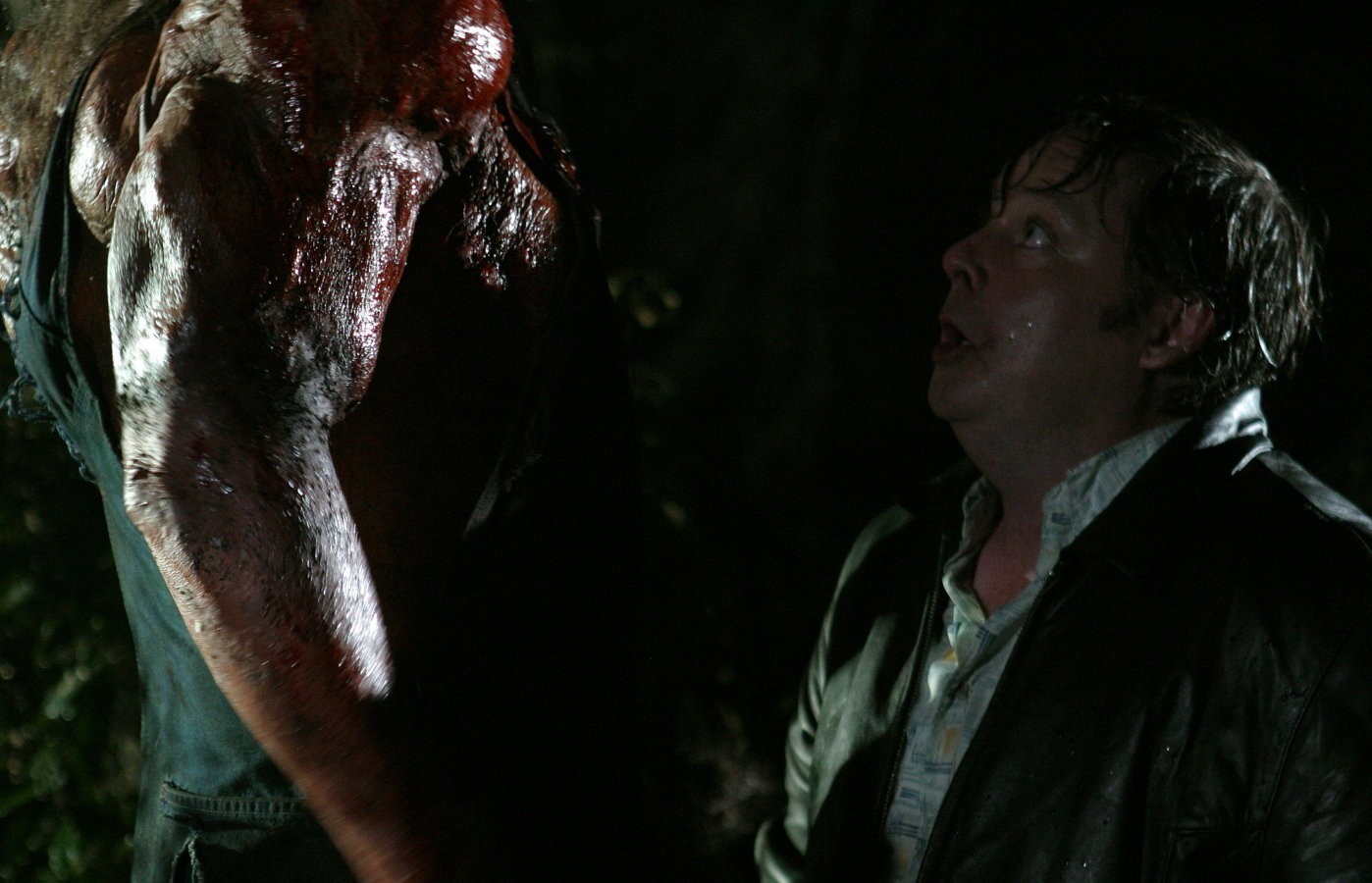 The film earned a reputation as a crowd-pleasing horror fave on the festival circuit in 2006. At its final festival screening, at Screamfest in Hollywood, October 2006, writer-director Adam Green told the eager audience. “Since we first showed it in March, this print has been all around the world, and I’ve been with it. Right now, I feel about like the print looks.†He pumped up the audience by adding, “Our best response has been in London, because those fuckers are crazy, but since this is the end of the tour and we’re back home, I think you can beat them. Let’s rip the roof off this place!†That was the first – but not the last -time that the audience erupted into applause.
The film earned a reputation as a crowd-pleasing horror fave on the festival circuit in 2006. At its final festival screening, at Screamfest in Hollywood, October 2006, writer-director Adam Green told the eager audience. “Since we first showed it in March, this print has been all around the world, and I’ve been with it. Right now, I feel about like the print looks.†He pumped up the audience by adding, “Our best response has been in London, because those fuckers are crazy, but since this is the end of the tour and we’re back home, I think you can beat them. Let’s rip the roof off this place!†That was the first – but not the last -time that the audience erupted into applause.
The poster art for the film’s festival tour proudly proclaimed that HATCHET is “old school horror†(circa 1980): “It’s not a sequel. It’s not a remake. And it’s not based on a Japanese one.†Truer words were never spoken.
After is festival run, HATCHET was picked up for home video distribution by Anchor Bay Entertainment, a company known for their excellent limited edition DVDs devoted to cult horror movies. The company opted to schedule for film for a platform theatrical release in 2007. The MPAA is likely to demand some major cuts in exchange for an R-rating. The film is strong enough to withstand the censors scissors without losing too much of its effectiveness.
SPOILER ALRERT: HATCHET drops a few subtle hints that lay the seeds for future sequels. In the flashback of the Halloween trick-or-treat gone wrong, the camera lingers on the masked face of one of the pranksters, without revealing his identity – which will probably be revealed in any follow-up. Most likely, he will turn out to be the alligator hunter, played by Robert Englund, who is an early victim in the film, making his death not one of random violence but of revenge.
HATCHET (2006). Written & directed by Adam Green. Cast: Joel David Moore, Tamara Feldman, Deon Richmond, Mercedes McNab, Kane Hodder, Parry Shen, Joleigh Fioreavanti, Joel Murray, Richard Riehle, Patrika Darbo, Robert Englund, Joshua Leonard, Tony Todd, John Carl Buechler
[serialposts]
Hot Fuzz is a Secret Splatter Movie – Borderland Film Review
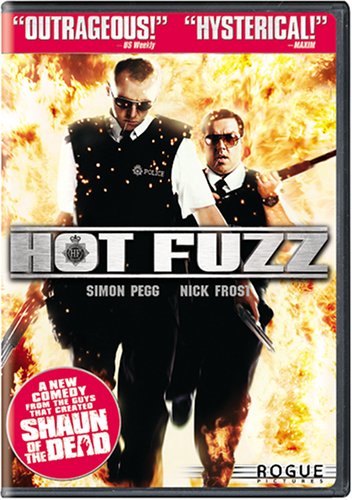 HOT FUZZ – from Edgar Wright and Simon Pegg, the team behind 2004’s wonderful zombie-comedy-romance SHAUN OF THE DEAD – at first resembles a spoof of cop movies. With Pegg as Nicholas Angel, an impossibly brilliant London police officer (not police “man”), who gets sent to a small village because his superiors are tired of the way his good example is making everyone else look bad by comparison. Needless to say, much comedy ensues from watching the supercop reduced to such trivial tasks as tracking down an escaped swan, before he finally uncovers a murderous conspiracy worthy of his talents. But surprise, surprise: the movie takes a big part of its inspiration not just from police-buddy movies (like BAD BOYS II, which is visually referenced in the film) but also from horror films. Continue reading “Hot Fuzz is a Secret Splatter Movie – Borderland Film Review”
HOT FUZZ – from Edgar Wright and Simon Pegg, the team behind 2004’s wonderful zombie-comedy-romance SHAUN OF THE DEAD – at first resembles a spoof of cop movies. With Pegg as Nicholas Angel, an impossibly brilliant London police officer (not police “man”), who gets sent to a small village because his superiors are tired of the way his good example is making everyone else look bad by comparison. Needless to say, much comedy ensues from watching the supercop reduced to such trivial tasks as tracking down an escaped swan, before he finally uncovers a murderous conspiracy worthy of his talents. But surprise, surprise: the movie takes a big part of its inspiration not just from police-buddy movies (like BAD BOYS II, which is visually referenced in the film) but also from horror films. Continue reading “Hot Fuzz is a Secret Splatter Movie – Borderland Film Review”
Grindhouse (2007) – Film Review

This homage to exploitation cinema of decades past seeks is not so much a movie as a gimmick that links together two feature films, plus a handful of faux trailers and advertisements – all appropriately scratched and faded to recreate the experience of attending a second-rate “grindhouse” theatre playing beat-up old prints. As amusing as the concept is, the actual result is a considerable disappointment – a high-tech forgery that lacks the disreputable charm of its models, which were made without the self-conscious affectation on display here. The movie is not without its merits, but it’s safe to say that much of it would have been derisively hooted off the screen at any real grindhouse theatre. In at least one sense, however, the film perfectly captures the grindhouse experience: it promises much more than it delivers.
GRINDHOUSE launches with its best foot forward, a fake trailer called “Machete,” starring character actor Danny Trejo as a Mexican man set up by the people who hired him to assassinate a senator. The brief flurry of outrageous violence, overblown dialogue, and hyperbolic narration yields the perfect recipe for an explosive blast of sheer, giddy fun that the rest of GRINDHOUSE cannot possibly match. Perhaps retrofitted exploitation is better in two-minute doses.
That brief opening exhilaration extends through the first few minutes of “Planet Terror,” written and directed by Robert Rodriguez. With a nod to George Romero’s zombie films like DAWN OF THE DEAD and DAY OF THE DEAD (whose make-up supervisor, Tom Savini, shows up in a supporting role), the story portrays a small town in Texas overrun by zombie-like mutants who have been infected by chemical weapons.
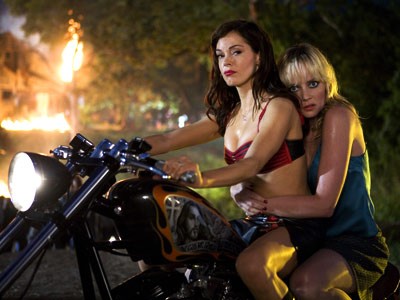
After getting off to a good start, the film bogs down in its narrative meanderings. In way, it too closely emulates its models: it’s boring, and you have to wait for the eruptions of gore and violence to break the boredom. By the time the jokey “Reel Missing” title card flashes on screen and the film jumps ahead as if several scenes have been lost, you’re grateful for the quickstep progress in what had hitherto been building tedium rather than tension.
When the shit hits the proverbial fan near the conclusion, the action blast across the screen in an unapologetic way, but the central visual conceit of actress Rose McGowan with a rifle in place of a leg never really comes off, yielding more derisive chuckles than gasps of excitement. (In the low point, she is supposed to blow smoke away from the recently fired weapon, and it is painfully obvious that she cannot get her mouth anywhere near enough to the barrel to have an effect.) At least the episode is partially redeemed by Rodriguez’s simple but effective music, a pounding, repetitive motif that recurs throughout in different permutations, a la Ennio Morricone and John Carpenter.
Next comes a trio of phony trailers: Rob Zombie’s “Werewolf Women of the S.S.,” Edgar Wright’s “Don’t,” and Eli Roth’s “Thanksgiving.” All are amusing, but none match the delights of the opening “Machete.” Wright’s stands out a bit by virtue of aiming at a target other than cheap exploitation films; its visual style consciously recalls higher-class efforts like 1973’s THE LEGEND OF HELL HOUSE (one actor is a dead ringer for Roddy McDowall, right down to his hair cut).
Roth’s trailer perfectly captures the washed-out look and downbeat “serious” tone of sleazeball horror films, and Zombie gets credit for making a mini-movie that includes both Udo Keir and Nicolas Cage (who, despite being an Oscar-winner, has shown a penchant for ham-handed scenary chewing that would be quite appropriate in a grindhouse movie).
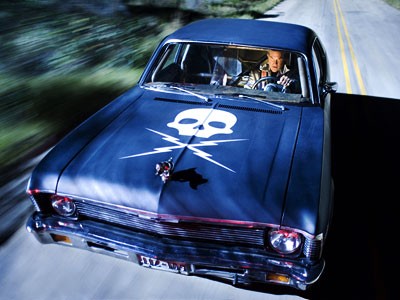
Next up is writer-director Quentin Tarantino’s “Death Proof,” which seems deliberately designed to piss off the target audience. One can admire the nerve it took promise “explicit sexuality and hard-core thrills” and then deliver a feature film that consists mostly of two groups of women sitting around in bars, cars, and cafes, talking about their personal lives; however, that does not make the result entertaining. There may be a sly strategy at work here: the character stuff is so boring that you eagerly look forward to the intrusion of death and violence, which takes the form of Kurt Russell as “Stuntman Mike,” who uses his car to plow through the first group of girls but gets more than he bargains for with the second. Unfortunately, Russell is not really the star of the episode – he is off-screen far too long – so his presence is not enough to save it. But he deserves high-fives all around for taking his despicable woman-killer and turning him into a pathetic loser who whines like a baby when the tables are turned on him.
The other big plus in “Death Proof” is the astounding stunt work by Zoe Bell (who doubled for The Bride in KILL BILL). Here, Bell plays herself, on vacation in America, where she goes on a test drive in a white Dodge (like the one from VANISHING POINT) and hangs off the hood suspended by nothing but a pair of belts. Tarantino gets his camera right in on the action so that you can see it is real, with Bell hanging on for dear life when she and her friends run afoul of Stuntman Mike.
Even so, the chase sequence never matches the thrills of BULLET, and Tarantino overplays his hand: several times, the driver of Bell’s care passes up opportunities to slow down and/or stop, so that Bell could get off the hood and back into the car; this stretches the situation out beyond belief or credibility, delaying what we really want to see – and what Tarantino finally delivers – Bell and friends turning the tables and putting Stuntman Mike in his place. Sadly, the comeuppance arrives, satisfying as it is, cannot possibly justify the time it took getting to it.
In the end, GRINDHOUSE is almost exactly the opposite of what it promises to be. Real grindhouse movies were made on fast schedules with few resources; the exploitation elements were necessary in order to give the audience some kind of entertainment value in exchange for their ticket-buying dollar. Running times were short (88 minutes fit into a single canister, making it cheaper to ship to theatres), and self-indulgent filmmaking was pretty much out of the question.
Rodriguez and Tarantino no doubt have sincere affection for these films, but they come across as posers – not too far from Pat Boone covering a Little Richard song. As much fun as the exploitation action is, it lacks the serious sleaze of the genuine article, and it’s not quite arch enough to amuse as camp. And for all the promise of balls-to-the-wall mayhem, what they deliver here is no more hardcore than anything we’ve seen in their previous films. Hopefully, if GRINDHOUSE II is ever made, the Dynamic Duo will take executive producer roles and hand over the directorial reigns to some young, hungry filmmaker eager to churn out a real grindhouse movie. Either that, or Rodriguez could make the actual feature-length version of “Machete.”
PARTING THOUGHT
Put crudely, one might say that watching GRINDHOUSE is a bit like watching two guys jerk each other off while staring at a Playboy centerfold. In their own minds, they’re having sex with a beautiful woman, and for some reason, they expect us to share their fantasy. But only a blindly loyal fan could be blind to the ugly truth.
TRIVIA
The (actual) trailers for GRINDHOUSE feature shots that are not in the final film (such as Kurt Russell saying “I’m not a cowboy; I’m a stuntman.” According to Rose MacGowan, Tarantino wrote a script for “Death Proof” that was long enough to be a stand-alone feature. Expect lots of deleted scenes (or an extended director’s cut) when the film arrives on DVD.
PLANET TERROR DIRECTOR’S CUT
For DVD, the GRINDHOUSE double bill was divided up into two titles, one for Robert Rodriguez’s PLANET TERROR and one for Quentin Tarantino’s DEATH PROOF. Each offerd an extended unrated director’s cut. The longer version of PLANET TERROR still begins with “Machete” – bogus preview for flick about a Mexican day laborer set up to take the fall for a political assassination – which was probably the highlight of GRINDHOUSE when it was in theatres. Unfortunately, the new cut does not alter PLANET TERROR in any major way – it just adds little bits and pieces throughout – so unless you loved the film to begin with, there’s not much reason to see it again. In case, you were wondering, despite restored footage, the “Scene Missing” title card remains in place, so you still will not learn what Wray said to convince the Sheriff to suddenly trust him.
Feast (2006) – Film Review
 This is one of the biggest and best-looking horror films of 2006; ironically, it was consigned to brief midnight movie screenings (in R-rated form) before heading off to home video, where it could be seen, unrated, in all its gory glory. The uncut version is a rip-roaring, blood-spattered blast of high-octane entertainment that is thoroughly enjoyable, exuberant fun that could have found a wide audience, despite the graphic and occasionally tasteless material that caused the ratings problems.
This is one of the biggest and best-looking horror films of 2006; ironically, it was consigned to brief midnight movie screenings (in R-rated form) before heading off to home video, where it could be seen, unrated, in all its gory glory. The uncut version is a rip-roaring, blood-spattered blast of high-octane entertainment that is thoroughly enjoyable, exuberant fun that could have found a wide audience, despite the graphic and occasionally tasteless material that caused the ratings problems.
FEAST works so well because it is a movie-movie that revels in its own artifice: the film openly reminds viewers that they are watching a movie, going gleefully over the top with its outrageous gore (not to mention disgusting monster sex), while simultaneously undermining genre expectations. Each human character is introduced with a subtitle giving a generic name, an occupation, and a life expectancy (e.g., “Name: Hero. Life Expectancy: Pretty Fucking Good!”) and then, as often as not, blowing the prediction out of the water.
The script by Dunston and Melton follows in the time-honored tradition of NIGHT OF THE LIVING DEAD, taking a disparate group of characters and trapping them in an isolated building (in this case a bar) besieged by ravenous monsters outside. The outrageous action that ensues is matched by director Gulager’s frenetic camera angles and high-speed editing, which turns the viewing experience into a high-grade adrenaline rush that almost never lets up from the opening moments until the final climax.
There is a small downside to the stylistic hysteria: the film becomes a lightening-paced fun house ride in which the gore and violence is rendered as an action-packed spectacle – full of suspense and thrills but devoid of emotional resonance. Consequently, when the film breaks one of the (usually) sacred taboos of the genre, killing off a child early on, the reaction is not one of horror and shock but more one of admiration that the filmmakers had the nerve to do the unthinkable. Most of the other deaths have a similar (lack of) impact, with the intentionally generic characters popped off like targets in a shooting gallery.
The silver lining to this dark cloud is that the film can – and often does – get away with almost anything, serving up decapitations and oral rape with equal gusto while never making us sympathize with the on-screen plight to the point where we might turn away in disgust. It’s obviously all make-believe, jolting the senses without offending the sensibilities, creating a galvanic response that makes FEAST one of the great audience-enthusiasm horror movies. It may be fun to watch on your television alone at night, but the experience really takes on expanded life in a crowd of enthusiastic viewers, hooting and hollering at the film’s verve and nerve. FEAST is too giddy to be truly ghastly; it simply serves up its horror with all the relish of the Grand Guignol tradition, like a full-frontal assault, without apology or restraint.
TRIVIA
The outrageous content earned FEAST an NC-17 rating from the MPAA. When released theatrically, the film was cut down for an R-rating. The DVD presents the unrated version, uncut. Among the restored footage is a disgusting moment at the end of a scene in which one of the female characters is raped by a monster – in her mouth. The fragmented editing leaves no doubt about what’s happening but prevents viewers from getting a clear look. Restored in the DVD is a shot whrein she spews white fluid from her mouth. Director John Gulager, responding to outraged viewers about how he could have filmed such a scene, responded, “That’s show business!”
BEHIND THE SCENES
FEAST was the result of a contest at Project Greenlight, a company set up by actors Matt Damon and Ben Affleck. In return for financing, director John Gulager and his crew were filmed during production for a reality television show, which aggravated all the usual on-set tension. Gulager (son of actor Clu Gulager [RETURN OF THE LIVING DEAD], who plays the film’s bartender) was ambivalent about the process: grateful that it gave him the money to make the film but unhappy with having dirty laundry aired in public.
“There are conversations that you have to have, because you’re making a film, that should be private,” he said after an October 2006 screening of the unrated version at the Screamfest Film Festival in Hollywood, “but we knew they were going to be on television. And then we would be interviewed about what we had said.”
Gulager also lamented the theatrical distribution of the movie. “It sucks!” he said, adding, “We could never figure it out. We’re getting a lot of airplay now, and it’s great that it’s coming out on DVD, but fuck, man, why couldn’t they do that for the midnight screenings? Nobody knew it was out. Now we have 140 35mm prints available for college screenings across the country.”
FEAST deserved a better shot in theatres than it got. Ironically, Screamfest screened the film immediately after SLITHER, which came out on DVD the same day – a film that got a major theatrical release from Universal Pictures and then fell flat on its face at the box office because its sensibility is entirely of a midnight-movie cult variety. FEAST might not have been a blockbuster, but it had a shot at being a sleeper hit if distributor Dimension Films had gotten the word out.
The silver lining to the story is that the project has opened doors. At the Screamfest screening, writers Marcus Dunstan and Patrick Melton said they were developing a murder-mystery television show and have another feature film planned, with Gulager involved. (In fact, they ended up scripting SAW IV for director Darren Lynn Bousman.) Gulager declined to discuss details, saying only that he has “another movie with Dimension, but I can’t say what it is. It’s a secret.”
FEAST(2006). Directed by John Gulgaer. Written by Marcus Dunstan & Patrick Melton. Cast: Duane Whitaker, Balthazar Getty, Chauntae Dvies, Diane Goldner, Josh Zuckerman, Henry Rollns, Eileen Ryan, Jason Mewes, judah Friedlander, Clu Gulager, Krista Allen, Anthony Criss, Jenny Wade, Tyler Patrick Jones, Eric Dane.
